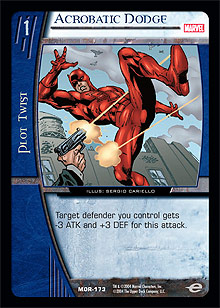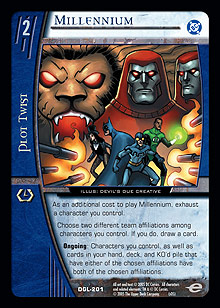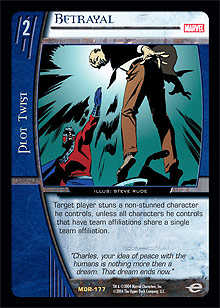I hope you guys had a pleasant week! I know I did. I got to head down to Atlanta to play in the $10K. It was the first time I’d actually been able to play in a $10K in quite some time. I only managed a mediocre 38th place finish, but I had an incredible time and came back with many, many stories that you can ask me to tell if you ever see me. Most of them probably shouldn’t see print, so I’ll leave it at that.
It’s time for week two of the Draft primer. Last week, we centered on what cards to take first out of the packs. If you’ll recall, the first things to go are good plot twists. Since most of the characters are roughly equivalent in terms of size and ability, cards that affect the equivalency of characters become a high priority. Today, we will be helping you to understand which plot twists are better than the others and thus should be first in consideration. We’ll also take a look at why they’re so good. So that you can follow along, here’s that part of the table of contents.
3. Plot Twists.......................................................................................7
Stat Modifiers..............................................................................8
Team-Ups..................................................................................11
KO Effects..................................................................................13
Other........................................................................................15
It seems pretty straightforward to me. According to this manual, there are four major types of plot twists. I’ll go straight to the text, because the author is a bit better than I am at explaining things.
 “As already discussed, plot twists should be the first things you look for when examining a pack. Which plot twists should you take, though? Unfortunately, like everything else in life, the answer is “it depends.” In order to understand which plot twists are better than others, it helps first to break them down into different types. There are four major categories of plot twists: stat modifiers, team-ups, KO effects, and everything else. Stat modifiers are any plot twists that change a character’s ATK, DEF, or both. Good examples of tier 1 stat modifiers include Acrobatic Dodge, Flying Kick, and Savage Beatdown. Team-ups are any plot twists that allow your characters to share affiliations. Some of the better team-ups to see print are Marvel Team-Up, Midnight Sons, and Millennium. Any plot twists that remove a stunned character from your opponent’s side of the board, be it by KO’ing them or merely by returning them to your opponent’s hand, fall under the category of KO effects. Good examples include Finishing Move, Sweeping Up, and Quick Kill. Finally, any plot twists that have a game effect that doesn’t mirror one of the first three types of plot twists ends up in the group entitled ‘other.’ Good others include Mystical Paralysis, Betrayal, and Lanterns in Love.”
“As already discussed, plot twists should be the first things you look for when examining a pack. Which plot twists should you take, though? Unfortunately, like everything else in life, the answer is “it depends.” In order to understand which plot twists are better than others, it helps first to break them down into different types. There are four major categories of plot twists: stat modifiers, team-ups, KO effects, and everything else. Stat modifiers are any plot twists that change a character’s ATK, DEF, or both. Good examples of tier 1 stat modifiers include Acrobatic Dodge, Flying Kick, and Savage Beatdown. Team-ups are any plot twists that allow your characters to share affiliations. Some of the better team-ups to see print are Marvel Team-Up, Midnight Sons, and Millennium. Any plot twists that remove a stunned character from your opponent’s side of the board, be it by KO’ing them or merely by returning them to your opponent’s hand, fall under the category of KO effects. Good examples include Finishing Move, Sweeping Up, and Quick Kill. Finally, any plot twists that have a game effect that doesn’t mirror one of the first three types of plot twists ends up in the group entitled ‘other.’ Good others include Mystical Paralysis, Betrayal, and Lanterns in Love.”
Okay, not a bad intro. Hopefully, you can understand why he chose to break down the categories this way and can figure out which plot twists fall into which categories. We’ll skip ahead a little bit and take a look at the plot twists in the order he mentioned them in his introduction. The section entitled “Stat Modifiers” is a little long, so I’ll only cover the parts I thought were important enough to highlight in multiple colors. The marker is a bit heavy, so it’s a little difficult to read. Here’s how it goes . . . I think.
“In Vs. System, when carefully examining the characters, it becomes apparent that most of them are of roughly the same size and ability. Some exceptional characters do exist and will be discussed later, but for now, know that most characters aren’t as different as their apparent variations would lead you to believe. A statistical breakdown of Vs. System will show that an average 3-drop is 4 ATK/4 DEF, an average 4-drop is 7 ATK/7 DEF, an average 5-drop is 9 ATK/9 DEF, and an average 6-drop is 12 ATK/12 DEF. Obviously, these are only averages and some aberrations do exist. For the most part, though, a character’s stats fall close to this range.
“Since most characters’ statistics fall into a similar range at any given drop, cards that affect these stats should be able to swing an attack in one character’s favor. The difference between a 4-drop’s average ATK and a 5-drop’s average DEF is only 2. Therefore, all it would theoretically take is a plot twist that gives a character at least +2 ATK, such as Flying Kick, for the average 4-drop to stun an average 5-drop. Conversely, if an average 5-drop were to attack another average 5-drop, a well-timed Acrobatic Dodge would effectively negate the attack.
“. . . The reason all of this is so important is because of the concept of ‘board advantage.’ Board advantage is achieved when your opponent has less of a board presence than you do. You can accomplish this by making sure that all your opponent’s larger, more expensive characters stun while you lose only your smaller characters. Stat modifying plot twists can help you achieve this. They allow characters to bridge the stat gap that exists between characters of different costs. When the ATK of a character is equivalent to the DEF of a more expensive character, an opportunity arises for the smaller character to stun a larger one, thus creating board advantage. This will be discussed in greater detail in the section on KO effects.”
There’s a bit more there about the different types of stat modifying plot twists and board advantage, but he covers it all really well later on, so there’s no point in wasting your time now. Up next is the section on team-ups. Affiliation is one of the keys to Vs. System, and this section explains why it’s so important and thus why team-ups are so good.
 “A team-up is any card that allows your characters to share affiliations or gain a new one. This include cards like Marvel Team-Up, Midnight Sons, and Millennium. They play an important role in a good deck. There are certain aspects of the game, such as reinforcement and team attacking, that are only available to characters of the same affiliation. Also, many cards are ‘team-stamped.’ This means that they require you to control a character of a certain affiliation to gain the full effect. Some good team-stamped cards include Micro-Size, Bring the Pain, and Emerald Twilight.
“A team-up is any card that allows your characters to share affiliations or gain a new one. This include cards like Marvel Team-Up, Midnight Sons, and Millennium. They play an important role in a good deck. There are certain aspects of the game, such as reinforcement and team attacking, that are only available to characters of the same affiliation. Also, many cards are ‘team-stamped.’ This means that they require you to control a character of a certain affiliation to gain the full effect. Some good team-stamped cards include Micro-Size, Bring the Pain, and Emerald Twilight.
“The effects of being able to reinforce and team attack are very profound. Most games of Vs. System are fairly close, at least if both decks are performing adequately. Saving extra damage is very important in these close games. Because of this, it’s easy to see why reinforcement is so important. Team attacking is another way to gain board advantage; because you are able to send two smaller characters to attack an opponent’s larger character, you free up your larger character to make attacks where it will not be forced to stun. This means that your opponent will lose more of his or her larger characters during recovery than you will. This is the essence of board advantage.”
Hopefully, that section went a long way toward raising your appreciation for team-ups. The effects they generate may seem trivial at first, but trust me, they really add up in the long run. Also, he keeps coming back to the topic of board advantage. If it’s still a little unclear what he means by that, take this as an example: If you can stun your opponent’s 4- and 5-drops while only stunning your own 3- and 4-drops, you’ll be in much better shape than he or she will be come recovery. You will get to keep your 4-drop, but your opponent will be forced to lose his or hers. KO effects generate a little bit more of an extreme board advantage, and the author goes into a little more detail on that in the next section.
“KO effects are any plot twists that remove a stunned character from your opponent’s side of the board. They can either KO the stunned character, like Finishing Move does, or return it to the opponent’s hand, like Sweeping Up does. These plot twists are among the most powerful in the game because of the enormous board advantage they create. Now it’s time for you to get a better understanding of the concept of board advantage.
“The first thing to do is to understand that if your opponent has to choose between KO’ing a 5-drop or a 4-drop during recovery and one isn’t clearly better than the other, he or she will without fail keep the most expensive character. It’s bigger and usually absorbs more damage than the smaller one. Because of the size difference between drops, it will be to your opponent’s advantage to keep the largest characters that he or she can each turn. Thus, from a board advantage point of view, it should be your goal to lose less of your expensive characters than your opponent does. That will give you more size than your opponent. If you have more size than your opponent, you have the advantage.
“Take the earlier example. Your opponent has a stunned 4- and 5-drop. Normally, he or she would choose to KO the 4-drop during recovery because it is much more advantageous to have a larger character on the table. With a KO effect (such as Finishing Move), the opponent is no longer given the choice of which character to recover. You KO the 5-drop and force the opponent into a less advantageous position. Having board advantage is so important in Vs. System that many games are lost because one player has more expensive characters on his or her side than the other. The ability to force a disadvantageous position upon your opponent is the prime reason that KO effects are viewed as such powerful cards.”
The concept of board advantage is both easy and hard to understand at the same time. It’s something that most players already know inherently but don’t have a name for. Many players already use it as a part of their play without realizing that they’re using it. This should help many of you who hadn’t thought of things this way before to get a better understanding of what’s important to winning a game in Vs. System. It’s a concept that will go a long way toward helping you determine the power levels of cards when choosing pick order.
Anyway, enough soapboxing for one day. The final part of this section starts on page 15. It’s kind of big, since there are so many plot twists that fall into categories other than the ones already described. However, I’ll trim it down and show you the two most important concepts outlined in the other category. The first is an expansion of board advantage, and the other is a section about stealing the initiative.
 “There are many plot twists that don’t fall into any of the aforementioned categories. Despite the fact that they’re all grouped here into the ‘other’ category, their effects are quite varied. However, they do all fall into similar subgroups based on the strategy they try to further within the game. The first subgroup is comprised of those cards that increase your board advantage. Cards like Betrayal and Lanterns in Love fall into this category. Another subgroup is plot twists that attempt to steal the initiative from your opponent. This includes cards like Mystical Paralysis and Spin Doctoring. These cards don’t actually steal the initiative, but their effects make it impossible for your opponent to get much accomplished on his or her initiative, thus effectively wasting it.”
“There are many plot twists that don’t fall into any of the aforementioned categories. Despite the fact that they’re all grouped here into the ‘other’ category, their effects are quite varied. However, they do all fall into similar subgroups based on the strategy they try to further within the game. The first subgroup is comprised of those cards that increase your board advantage. Cards like Betrayal and Lanterns in Love fall into this category. Another subgroup is plot twists that attempt to steal the initiative from your opponent. This includes cards like Mystical Paralysis and Spin Doctoring. These cards don’t actually steal the initiative, but their effects make it impossible for your opponent to get much accomplished on his or her initiative, thus effectively wasting it.”
I want to cut in and let you know something I marked down in the margins as I was reading over this long ago. Both of the effects he’s described here have something in common—both take away your opponent’s ability to use his or her initiative effectively. Initiative is one of the most powerful forces in this game. Being able to attack first means that you get to stun the characters you want. You also get to use any effects that trigger at the start of your combat before your opponent does. In short, the initiative means that you make all of the decisions. Since initiative is so valuable, effects that take the initiative must be incredibly powerful.
I want to point out, though, that only a few cards have been printed that outright steal the initiative, and those that have seen print have some of the steepest drawbacks of any cards. I’m not talking about them, though. I’m talking about cards that allow you to make decisions on your opponent’s turn. If you can make it so that your opponent didn’t get anything accomplished on his or her initiative, he or she might as well have not even taken a turn. And, since initiative is so advantageous, you’ve just bettered your own position. And now, let’s go back to the text.
“Some of the cards in the ‘other’ category go a long way toward bettering your board advantage. Betrayal, for example, allows you to outright stun one of your opponent’s characters as long as they aren’t all of the same affiliation. This allows you to stun a character without jeopardizing one of your own. Since board advantage is achieved whenever your opponent has to stun more or better characters than you do, it should be easy to see how this helps your cause.
“Lanterns in Love actually has an equivalent but opposite effect. Instead of securing your advantage by forcing one of your opponent’s characters to KO, it allows you to recover one of your own stunned characters, thus preventing you from losing your most expensive character. This keeps your opponent from cementing his or her board advantage, which has the same effect as cementing your own.
“. . . Preventing your opponent from doing anything of value on his or her initiative is essentially the same as simply stealing the initiative. Mystical Paralysis accomplishes this feat by using Dr. Doom to exhaust your opponent’s largest character. This usually prevents your opponent from stunning your larger characters, or if he or she chooses to team attack, it prevents the stunning of multiple characters. This minimizes the effect your opponent’s turn will have on you and thus takes away part of the power of his or her initiative.
“Spin Doctoring works in a very similar way. Usually, the character you have in play will require a great effort from your opponent to stun. Being able to recover that character will often leave your opponent unable to attack through it successfully again, thus forcing him or her to end the turn. Since your opponent was forced to end his or her turn prematurely, you have effectively stolen the initiative.”
I hope this helped you to get a better understanding of not only the plot twists in a set, but also of some of the more in-depth strategies present in Vs. System. These concepts are not easy to grasp on the first try, so it’s understandable if it takes a bit of work to get the hang of them. As always, I’m reachable by email at the_priceis_right@yahoo.com. Please send any questions to me there and I’ll try to incorporate those that fit into my next article. Until then, have a good week, and I’ll be back with a little discourse on characters next week.